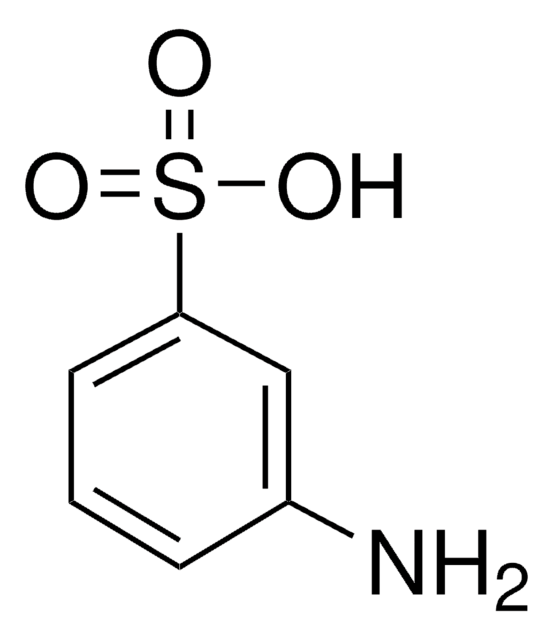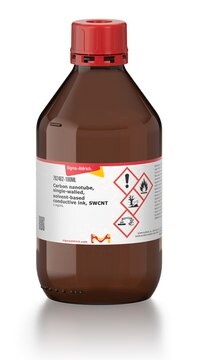639230
Kohlenstoff-Nanoröhrchen, einwandig, Polyaminobenzolsulfonsäure-funktionalisiert
75-85% carbon basis, D × L 1.1 nm × 0.5-1.0 μm , bundle dimensions, avg. no. of layers, 1
Synonym(e):
Kohlenstoffnanoröhrchen, einwandig, PABS-funktionalisiert, SWNT, PABS-funktionalisiert
About This Item
Qualitätsniveau
Assay
75-85% carbon basis
Form
powder
Mol-Gew.
average Mw 400-600 g/mol (PABS)
Leistungsmerkmale
avg. no. of layers 1
Kennzeichnungsgrad
65% (PABS, typical)
T × L
1.1 nm × 0.5-1.0 μm , bundle dimensions
Verunreinigungen
4% metals
Löslichkeit
ethanol: 0.05 mg/mL
DMF: 0.1 mg/mL
H2O: 5.0 mg/mL (As determined by near-IR absorbance spectroscopy.)
Funktionelle Gruppe
sulfonic acid
Verwandte Kategorien
Allgemeine Beschreibung
Anwendung
Verpackung
Angaben zur Herstellung
Hinweis zur Analyse
Signalwort
Warning
H-Sätze
Gefahreneinstufungen
Eye Irrit. 2 - STOT SE 3
Zielorgane
Respiratory system
Lagerklassenschlüssel
11 - Combustible Solids
WGK
WGK 3
Flammpunkt (°F)
Not applicable
Flammpunkt (°C)
Not applicable
Persönliche Schutzausrüstung
dust mask type N95 (US), Eyeshields, Gloves
Analysenzertifikate (COA)
Suchen Sie nach Analysenzertifikate (COA), indem Sie die Lot-/Chargennummer des Produkts eingeben. Lot- und Chargennummern sind auf dem Produktetikett hinter den Wörtern ‘Lot’ oder ‘Batch’ (Lot oder Charge) zu finden.
Besitzen Sie dieses Produkt bereits?
In der Dokumentenbibliothek finden Sie die Dokumentation zu den Produkten, die Sie kürzlich erworben haben.
Kunden haben sich ebenfalls angesehen
Artikel
Carbon nanotubes are materials that possess remarkable properties and offer extraordinary possibilities.
Carbon nanotubes (CNTs) have received much attention since their discovery in 1991 by Sumio lijima1 due to their excellent mechanical, electrical, and optical properties.
A nanocomposite is typically defined as a mixture between a host material (e.g., polymer matrix) and nanofillers with at least one dimension of less than 100 nm.
Single-walled carbon nanotubes (SWCNTs) are promising materials for use in the active channel of field-effect transistors (FETs), photoabsorbing layers of solar cells and photodetectors because of their ultrafast charge transport mobility.
Unser Team von Wissenschaftlern verfügt über Erfahrung in allen Forschungsbereichen einschließlich Life Science, Materialwissenschaften, chemischer Synthese, Chromatographie, Analytik und vielen mehr..
Setzen Sie sich mit dem technischen Dienst in Verbindung.



